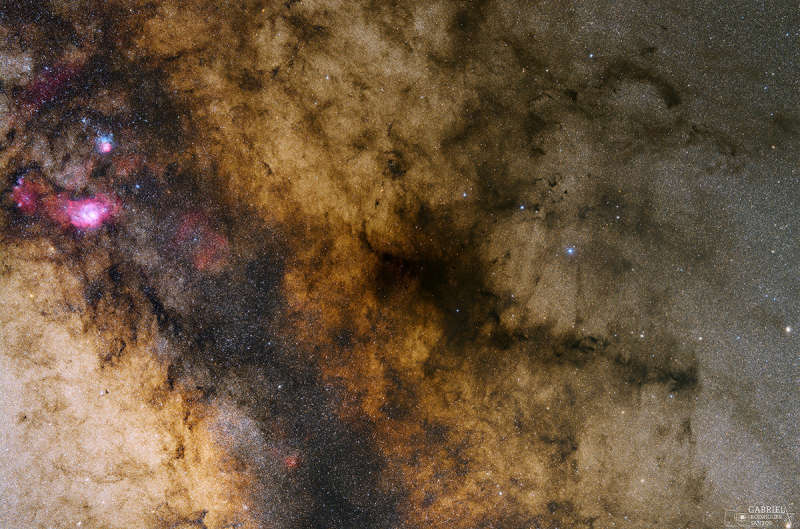
|
Credit & Copyright: Gabriel Rodrigues Santos
Explanation:
Dark markings and colorful clouds
inhabit this stellar landscape.
The deep and expansive view spans more than 30 full moons across
crowded star fields toward the center of our Milky Way Galaxy.
Cataloged
in
the early 20th century by astronomer
E.
E. Barnard,
the obscuring interstellar dust clouds seen toward the right
include
B59, B72, B77 and B78,
part of the Ophiuchus molecular cloud complex a mere 450 light-years away.
To the eye their combined shape
suggests a pipe
stem and bowl, and so the dark nebula's popular name is
the Pipe Nebula.
Three bright nebulae gathered on the left are
stellar nurseries some 5,000 light-years distant toward
the constellation Sagittarius.
In the 18th century astronomer
Charles
Messier included
two of them in his catalog of bright clusters and nebulae; M8, the
largest of the triplet,
and colorful M20 just above.
The third prominent emission region includes NGC 6559 at the far left.
Itself divided by obscuring dust lanes, M20 is also known as
the Trifid.
M8's popular moniker is
the Lagoon Nebula.
|
January February March April May June July August September October November December |
| ||||||||||||||||||||||||||||||||||||||||||||||||
NASA Web Site Statements, Warnings, and Disclaimers
NASA Official: Jay Norris. Specific rights apply.
A service of: LHEA at NASA / GSFC
& Michigan Tech. U.
Based on Astronomy Picture
Of the Day
Publications with keywords: dark nebula - Milky Way
Publications with words: dark nebula - Milky Way
See also:
- APOD: 2025 November 19 Á Chamaeleon Dark Nebulas
- APOD: 2025 July 2 Á Milky Way Through Otago Spires
- APOD: 2025 May 20 Á Milky Way over Maunakea
- APOD: 2025 May 13 Á Gaia Reconstructs a Top View of our Galaxy
- APOD: 2025 May 12 Á Gaia Reconstructs a Side View of our Galaxy
- Galaxies in Space
- APOD: 2025 February 9 Á Milky Way over the Australian Pinnacles
